|


 | Introduction |
| Introduction |
| Butterfly Gardening |
 Swallowtails
Swallowtails
Sulfurs/Whites
Brushfooted
Little
Snout
 Host
Host
Nectar

T-shirts
Mugs
Magnets
Clocks
Tote Bags
Framed Tiles
Notebooks
Postcards
Light Switch Covers
Tile Coasters
 Books
Books
Web Sites

|
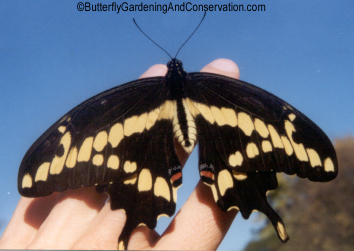
Adult Giant Swallowtail.
Giant Swallowtails are the largest butterfly in much of the US. Their wingspan ranges from 3.5 to
5.5 inches across! They tend to stay in woodland areas or, in the southern US, in citrus groves.
The adults sip flower nectar for food.
Giant Swallowtail Host Plants
Host plants include citrus such as orange, lemon and lime trees in the south and further north:
Hop Tree/Wafer Ash - Ptelea trifoliata,
Prickly Ash - Zanthoxylum americanum and
Rue - Ruta graveolens
- all citrus family plants.
Giant Swallowtail Life Cycle
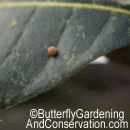
A Giant Swallowtail egg.
Their eggs can be yellowish, orangish or green and are laid singly on host plant leaves and twigs.
The diameter of their eggs is a little over 1 mm.
The caterpillars look a lot like bird droppings and can get as big as 4.5 cm long!
Caterpillars of many butterfly species tend to change their appearance as they develop. Giant
Swallowtail caterpillars however do not change their appearance very much. Some species
tend to look a bit like bird droppings when they are smaller but later turn bright green, or get
stripes, etc. Giant Swallowtails retain the bird dropping appearance until they pupate.
First instar caterpillars are around 2.5 to 3 mm long right after hatching, but grow quickly.
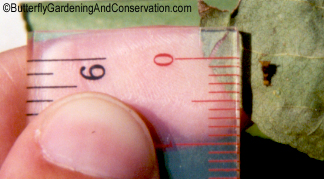
This picture was taken right after this one hatched. Unfortunately, there is a
shadow to the right of its body, which makes it a little hard to see. Notice the pattern of
light-dark-light-dark-light coloration.
|
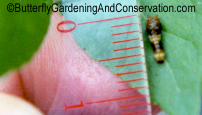
This is also a first instar caterpillar, the picture was taken just 2 days after
it hatched. Notice the light color around its head area is now darker, giving it a pattern of
dark-light-dark-light.
|
Second instars look pretty much the same, only bigger.
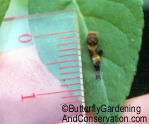
2nd instar right after molting, old skin can be seen laying behind it. The dark,
round thing laying to its right is its old head capsule, which always falls off separately from
its skin when molting.
|

This is a view from the side. Its head is still light colored after having molted.
|
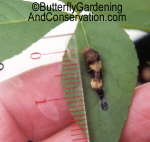
Third instar right after molting.
|
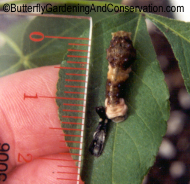
Fourth instar right after molting.
|
|
As mentioned earlier, the appearance of Giant Swallowtail caterpillars doesn't
change too much as they develop!
|
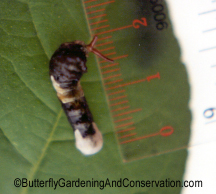
Late 4th or early 5th instar sticking out its osmetrium.
Swallowtail caterpillars have an orange/red fleshy forked organ called an osmetrium that they stick out
when distubed to scare off predators. Osmetria give off a bad smell when stuck out -
from two chemicals
released from it.
Fifth instar caterpillars do change their appearance a little from that of the earlier instars.
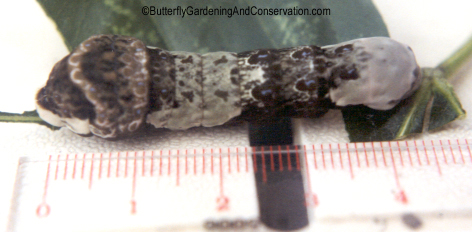
|
|
Nearly full grown fifth instar Giant Swallowtail caterpillar.
|
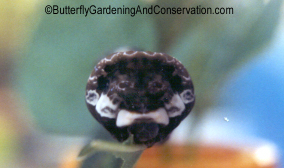
|
|
Fifth instar Giant Swallowtail caterpillar from the front.
|
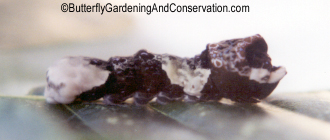
|
|
Fifth instar Giant Swallowtail caterpillar from the side.
|
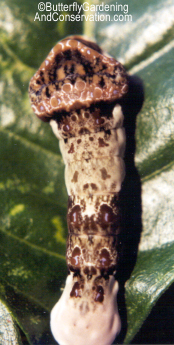
Fifth instar close-up showing more detail.
As mentioned earlier, fifth instars do change their appearance from the earlier stages.
The picture to the right is a close up that shows more detail. While they aren't the
prettiest of caterpillars, the color pattern is complex and pretty in its own sort of way.
The chrysalis of Giant Swallowtails also have an interesting appearance. Unfortunately my
pictures didn't turn out too good, problems with the lighting it looks like. Their shape is
similar to other swallowtails and its overall appearance still looks like bark on a tree. Giant
Swallowtail pupa also have a greenish coloring to them that looks kind of like mold or moss growing
on a tree.
The beauty of the adults more than make up for any shortcomings in the appearance of the caterpillars.
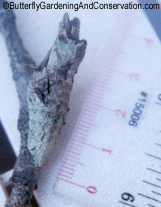
|
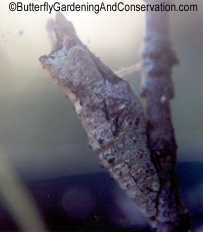
|
|
Giant Swallowtail chrysalis.
|
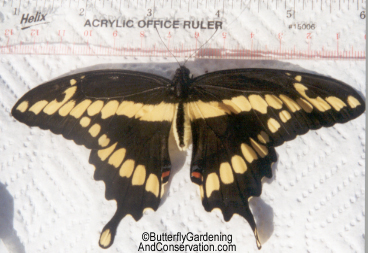
|
|
Adult Giant Swallowtail with wings open. Notice the ruler next to it, its wingspan
is 13 cm long! (about 5 in.)
|
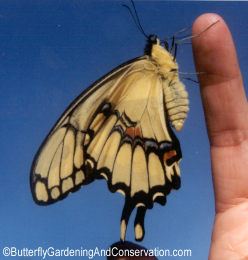
|
|
Giant Swallowtail from the side.
|
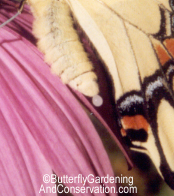
This picture is a zoomed in part of the picture on the right. The drop
of liquid hanging from its body is called meconium, which is a waste material butterflies release from their
bodies after coming out of their chrysalis, it can also be brown, red or green in color.
|

|
Butterfly Gardening Home |
Butterfly Gardening Articles |
Butterfly Species |
Plants |
Butterfly and Gardening Shopping |
T-shirts |
Mugs |
Magnets |
Clocks |
Tote Bags |
Framed Tiles |
Notebooks |
Postcards |
Light Switch Covers |
Tile Coasters |
Calendars |
Butterfly Calendars |
Resources |
Contact |
Blog |
[old blog] |
© 2003 - 2025 ButterflyGardeningAndConservation.com
Today is: 4 November 2025, 3:48 am |
|





